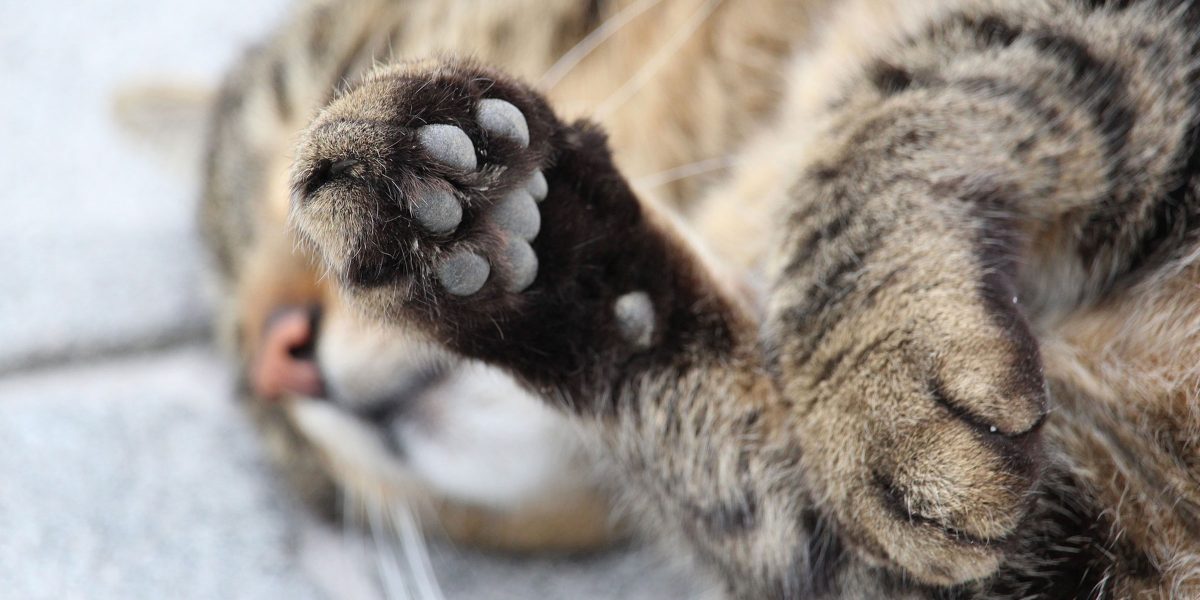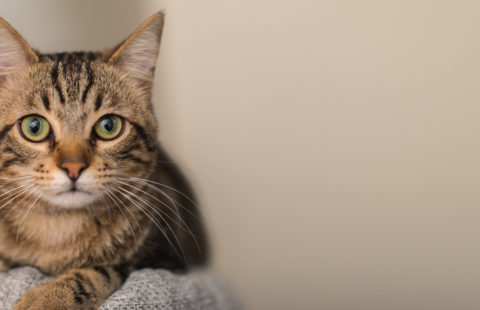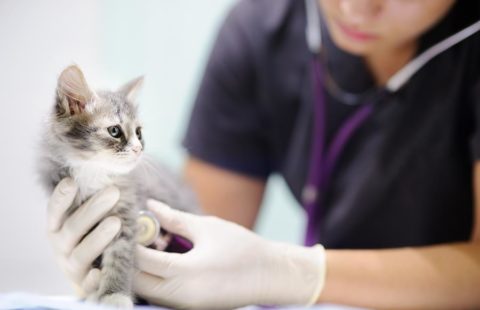Sevim Isparta and Dr. Yasemin Salgirli Demirbas are two veterinary research scientists from the Faculty of Veterinary Medicine in Ankara, Turkey. Along with Professor Gonçalo Da Graça Pereira from the Escola Superior Agrária de Elvas in the Polytechnic Institute of Portalegre, Portugal, they kindly introduce us to the topic of laterality, how cats demonstrate this with their paw preferences and talk us through the recent study they co-authored with colleagues from Germany on the relationship between problem-solving ability and laterality in cats.
The two hemispheres of the brain are not the same. They differ both in structure and in the functions they control. This phenomenon is called hemispheric asymmetry. Functional hemispheric asymmetries can be measured by observing lateralized behaviours such as handedness in humans. About ninety per cent of the human population is right-handed when performing tasks such as writing, painting or holding. Since one side of the brain controls the behaviour on the other side, the dominant hemisphere of most of the people is the left hemisphere. Although it was believed that this feature was unique for humans, recent studies showed that it is indeed a common vertebrate feature, which provides an evolutionary advantage for different animal species. Lateralized brains can have both hemispheres working simultaneously, with each hemisphere processing different information from different sources. For example, in one study it was demonstrated that lateralized chicks can be alert to possible predators while they simultaneously find food. Strong lateralization is important for advanced cognitive skills. Having a dominant hemisphere to control certain cognitive functions, i.e. hemispherical specialization reduces selection time for any cognitive response, and thus, it minimises neural conflicts between two hemispheres. Accordingly, lateralized individuals are expected to have higher perceptual, cognitive, and motor abilities.
What about cats? Do they demonstrate lateralized behaviour when it comes to their paws? Is there a tendency for cats to be left or right pawed?
Paw preference in cats has always been a topic of interest to both cat owners and researchers. The pioneer studies on functional asymmetries in cats were conducted by Graystyan and Molnar in 1954, which was then followed by more than 30 scientific studies to date. A recent meta-analysis study on paw preference of cats showed that cats do not show a population level asymmetry, ie, cats do not show a tendency towards right or left pawedness at the population level. Unsurprisingly, 78% of cats studied use their dominant paws (whether it is their left or right) for performing certain tasks to assess paw preference set up by scientists. What was a really interesting result of the meta-analysis study is that left-pawedness in cats is 3 to 4 times higher than left-handedness in humans. One possible explanation for this brings us back to the ancestry of the domestic cat. The right hemisphere of the brain controls the processing of fear and stimulates withdrawal in novel situations. As the cat is a solitary animal responsible for its own survival, its most preferred survival strategy is avoidance in most cases. Thus, having a brain that is sensitized to processing potential danger is advantageous for a solitary animal. Humans, on the other hand, are socially obligate mammals that rely on social relations. Such cognitive processing for social relationships occurs within the left hemisphere, hence the bias towards right handedness. So, we think, it is not surprising to see that left-handedness is much more common in cats in comparison to humans.
Why is it so important to assess paw preferences in cats?
Domestic cats are one of the domestic species that still share similar genetic, morphological and behavioural patterns with their ancestors. Despite them now living in our homes as pets, we have done little to change their natural instincts. They are obligate carnivores which require a meat-based diet and despite us feeding them, they still have a strong desire to hunt. Such hunting behaviour requires complex motor skills to successfully capture and consume prey. For example, they need to use their paws efficiently to hunt, hold and manipulate their prey. Having a dominant paw may be, thus, important to increase their success rate at hunting and ultimately for those cats without people feeding them, their survival. Although the provision of puzzle feeders also encourage the use of paws during feeding as does play behaviour.
The relationship between problem-solving ability and laterality in cats – our study
In different species, it was shown that strong laterality is associated with increased cognitive ability. Advanced cognitive abilities such as problem-solving, planning, self-control and learning are important skills for becoming an efficient hunter. Thus, laterality is not just important for skilled paw usage, the strength of the laterality may also be linked to enhanced cognitive ability.
We recently published a study about the link between laterality and problem-solving ability in cats in the journal Behavioural Brain Research. We investigated whether cats with stronger paw preferences demonstrate higher motor and cognitive abilities.
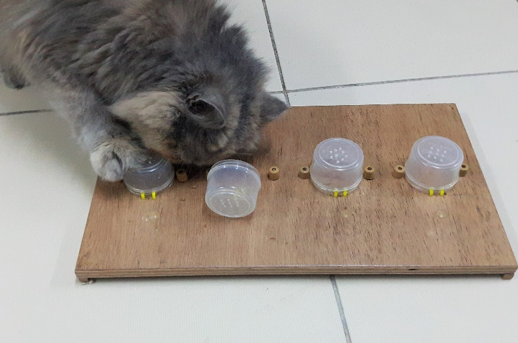
Fig 1. A cat performing the first problem-solving test where it needs to pull or push the plastic tub to reveal the food on the wooden board.
What did we do?
We tested 41 healthy domestic cats of various breeds by using two different novel problem-solving tasks that we developed. In both tasks, the cats needed to open a lid in order to reach the food reward (see Figures 1 and 2). Accordingly, we measured the strength and direction (left or right) of their paw preferences.
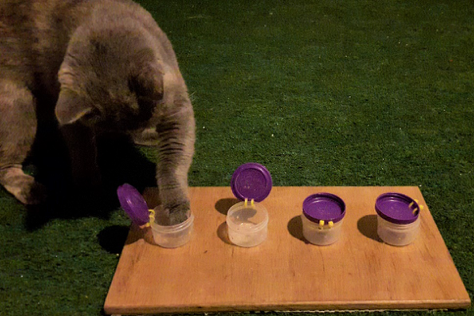
Fig 2. A cat performing the second problem-solving test. Cats had to first open the lids and then needed to reach inside the cups in order to gain access to the food reward. Each opening faced towards a different direction than the others.
What did we find?
We found a significant correlation between paw preferences and problem-solving ability (in this case, accessing the food reward in our two novel food reaching tasks).
Do lateralized cats have an advantage?
We showed that cats that had a clear preference for one paw were able to open more lids successfully than ambilateral animals (ie, those with no preference for using the left or right paw). Moreover, the cats with the clear paw preference managed to open the lids with less paw manipulation. These results yield support to the idea that lateralization is linked to cognitive abilities.
Any unusual findings?
In our study, we found that cats don’t only use their paws in the food reaching tasks – some in fact used their heads to push open the lids to reveal the food! We therefore categorised the cats as head- and paw-preferred strategy depending on their first choice to interact with the task apparatus. Cats that preferred to interact with the tasks using their paws were more successful as they opened more lids (and got more food!) than the cats that preferred to use their head first. One of the reasons for using the head rather than paw for the initial attempt to start the task might be the impact of the domestication process. This conclusion is based upon the literature that unlike the feeding and hunting rituals of wild cats, domestic cats are generally fed from a bowl in a fixed position without requiring any manipulative motor skills. This finding requires further investigation to provide greater insights into the usability of the paw and/or head preferences for an intelligence tool in cats.
Was the first paw used in the tasks an indicator for general paw preference?
As those working with cats know very well, evaluating cat behaviour is a very demanding job that requires complete attention. The study has a promising result for cat paw preference studies that suggests that initial paw preference may be an indicator of cats’ overall paw preference.
Why did we perform two food reaching tasks?
It is known that humans and primates prefer to use their dominant hands in difficult activities as more fine motor skills are required to be successful in those activities. So, their preferred side may change depending on the complexity of the task. We wanted to know whether cats, like humans, have task-dependent side bias or not. So, they performed two novel problem-solving tests with different complexity and lid opening strategies. We found that individual side preferences in cats are stable and task-independent, at least when it comes to food reaching tasks!
Has this left you wondering if you own cat has a paw preference? Here’s how you can test your own cat’s paw preference?
To find out about your cat’s paw preference, you can use a food reaching test similar to the ones we designed in our study (see Figure 1 and 2) or try commercially available or homemade puzzle feeders. You can get an overview of your cat’s paw choice by observing his or her paw manipulations while trying to access the food. Repeat several times by refilling the tubs with food and record each time which paw your cat uses. Don’t forget that in our study, the first attempt was a good prediction of the cat’s paw preference – is this the same for your cat?
A big thank you to Sevim Isparta, Yasemin Salgirli Demirbas and Gonçalo Da Graça Pereira for the fascinating insight into lateralization. The original paper detailing this study can be accessed here.
Isparta, S., Demirbas, Y.S., Bars, Z., Kul, B.C., Güntürkün, O., Ocklenburg, S., Pereira, G.D.G., 2020. The relationship between problem-solving ability and laterality in cats. Behav. Brain Res., 391,112691.
Did you know that cats show other lateralized behaviours including ear turns, eye gaze and head turns? There is some thought that such lateralized behaviours could be used an indicators of the emotional state of the cat.
If you work with cats and want to learn more about problem solving abilities in the cat and what makes them behave the way they do, consider our online course Advanced Feline Behaviour for Cat Professionals



